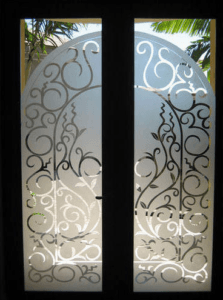Glass etching, or “French embossing,” is a popular technique developed during the mid-1800s that is still widely used in both residential and commercial spaces today. Glass etching comprises the techniques of creating art on the surface of glass by applying acidic, caustic, or abrasive substances. Traditionally this is done after the glass is blown or cast, although mold-etching has replaced some forms of surface etching. The removal of minute amounts of glass causes the characteristic rough surface and translucent quality of frosted glass.
Various techniques are used to achieve an etched surface in glass, whether for artistic effect, or simply to create a translucent surface.
Acid etching is done using hexafluorosilicic acid (H2SiF6) which, when anhydrous, is colourless.
Glass etching cream is used by hobbyists as it is generally easier to use than acid.
Abrasive blasting (“sandblasting”) is another common technique for creating patterns in glassware, creating a “frosted” look to the glass. It is often used commercially. High-pressure air mixed with an abrasive material cuts away at the glass surface to create the desired effect.
Mold etching In the 1920s a mold-etch process was invented, in which art was etched directly into the mold, so that each cast piece emerged from the mold with the texture already on the surface of the glass.
Frost etching is the process in which vinyl window material is cut to produce a pattern and then applied to a window to give a frosted patterned effect.

